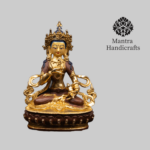
Masterpiece Guru Rinpoche | Padmasabhava Statue: A Spiritual Icon of Tibetan Buddhism
In the vast spiritual landscape of Tibetan Buddhism, few figures hold as much reverence and significance as Guru Rinpoche, also known as Padmasambhava. His life and teachings are fundamental to the establishment of Buddhism in Tibet, and he is often considered the second Buddha. The Padmasabhava statue, a masterpiece in its artistic form and spiritual presence, captivates devotees and art enthusiasts alike.
The Historical Context of Guru Rinpoche
Guru Rinpoche was an 8th-century Indian sage and teacher who played a crucial role in the spread of Buddhism in Tibet. According to tradition, he was invited by King Trisong Detsen to help establish Buddhist doctrine and practices in the region. Rinpoche is credited with subduing local deities and spirits, transforming them into protectors of the Buddhist faith, and establishing the Nyingma school of Tibetan Buddhism. His life is documented in various texts, including “The Life and Teachings of Padmasambhava,” which illuminate not only his teachings but also his miraculous feats and wisdom.
The Artistic Representation of Padmasabhava
The Padmasabhava statue is renowned not only for its aesthetic beauty but also for its profound spiritual symbolism. Statues of Guru Rinpoche typically depict him in a variety of forms, each representing different aspects of his being and teachings. Commonly, he is shown seated on a lotus, symbolizing purity and enlightenment, wearing a crown adorned with jewels which signify his royal status among enlightened beings.
These statues are often made from bronze and gilded with gold, embodying the richness of Tibetan culture and spirituality. Intricate details such as fine carvings, colorful paint finishes, and ornate decorations reflect the high level of craftsmanship characteristic of traditional Tibetan art. Each element of the statue is imbued with meaning, from the posture of the figure to the items he holds, such as a vajra (representing power) and a bell (symbolizing wisdom), both of which embody the dual teachings of compassion and wisdom.
Symbolism and Significance
The significance of the Padmasabhava statue extends beyond mere artistic representation; it serves as a conduit for spiritual practice and devotion. In Tibetan culture, statues are not only art; they are considered to embody the presence of the deity they represent. Devotees often engage in rituals, prayers, and offerings in front of the statue, believing that this connection fosters spiritual growth and insight.
Moreover, the practice of creating and venerating Padmasabhava statues is tied to the concept of siddhis—spiritual powers that can be attained through meditation and practice. The statue of Guru Rinpoche acts as a reminder of the potential within each practitioner to cultivate their inner wisdom and compassion.
The Global Influence of Padmasabhava
As Buddhism has spread beyond its Himalayan roots to various parts of the world, the image of Padmasambhava has also found a place in the hearts and homes of many. In contemporary spiritual discussions, Guru Rinpoche’s teachings on overcoming obstacles and transforming challenges into opportunities for growth resonate with individuals seeking a deeper understanding of their own spiritual journeys.
The increasing interest in Tibetan Buddhism and the teachings of Padmasambhava has led to the establishment of various centers and temples worldwide, where practitioners gather to study his teachings and conduct rituals. Statues of Guru Rinpoche serve as focal points in these spaces, bridging ancient wisdom with modern practice.
Conclusion
The Padmasabhava statue is far more than a work of art; it is a dynamic symbol of spiritual aspiration and transformation. Representing the life and teachings of Guru Rinpoche, it inspires countless individuals who seek to navigate their paths of enlightenment. Through its intricate craftsmanship and profound symbolism, the statue connects the past and present, serving as a reminder of the timeless wisdom that Guru Rinpoche imparted and the enduring impact of his legacy on both Tibetan Buddhism and the wider world. As we continue to explore the depths of Guru Rinpoche’s teachings, the Padmasabhava statue invites us all to embark on our own journeys toward awakening and compassion.




